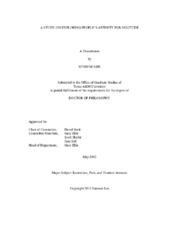| dc.contributor.advisor | Scott, David | |
| dc.creator | Lee, Sunwoo | |
| dc.date.accessioned | 2013-10-02T21:27:00Z | |
| dc.date.available | 2013-10-02T21:27:00Z | |
| dc.date.created | 2013-05 | |
| dc.date.issued | 2013-01-09 | |
| dc.date.submitted | May 2013 | |
| dc.identifier.uri | https://hdl.handle.net/1969.1/149243 | |
| dc.description.abstract | This study sought to investigate solitude as a phenomenon. People’s affinity for solitude and the antecedents of affinity for solitude were of crucial interest to the study because affinity for solitude has been considered a strong determinant of solitude behavior. Based on the review of existing solitude studies, major constructs believed to comprise an empirical model were theoretically and operationally defined: affinity for solitude, general attitudes toward solitude, subjective norms, perceived control, extraversion, intended solitude behavior, and actual solitude behavior. The relationships among latent factors were hypothesized for empirical tests.
A questionnaire was designed to measure the above constructs. Several items were based on previous studies although several items were developed by the investigator. A total of 395 college students, 162 male and 233 female students completed an online survey in exchange for extra credit. Preliminary analysis indicated the internal consistency of the battery of measurement scales used in this study were highly reliable; the measurement test also provided empirical evidence of the construct validity of the developed measures.
A test of the hypothesized model of people’s affinity for solitude revealed that there were well-defined path relationships between latent factors with a good fit between the measures and the sample data. Findings revealed that general attitudes toward solitude and subjective norms positively contributed to affinity for solitude; while extraversion negatively influenced affinity for solitude. Affinity for solitude effectively predicted intended solitude behavior and actual solitude behavior. Additionally, the study found that subjective norms and general attitudes toward solitude also significantly predicted intended solitude behavior.
A model of people’s affinity for solitude and solitude behavior allowed us to analytically view the latent social and cognitive factors that significantly inform people’s affinity for solitude and their solitude behavior. This study is valuable in two ways. First, theoretical and empirical approaches derived from this current study suggest ways of conceptualizing solitude attitudes and behavior. Second, study findings account for the antecedents and consequences of affinity for solitude.
Theoretical relations and several implications associated with college students and recreation management were presented. Additionally, the limitations of the study followed by suggestions for improvements and possible directions for future research were discussed. | en |
| dc.format.mimetype | application/pdf | |
| dc.subject | Affinity for solitude | en |
| dc.subject | Subjective norms | en |
| dc.subject | General attitudes toward solitude | en |
| dc.subject | Perceived control | en |
| dc.subject | Extraversion | en |
| dc.subject | Solitude behavior | en |
| dc.title | A Study on Exploring People’s Affinity for Solitude | en |
| dc.type | Thesis | en |
| thesis.degree.department | Recreation, Park, and Tourism Sciences | en |
| thesis.degree.discipline | Recreation, Park, and Tourism Sciences | en |
| thesis.degree.grantor | Texas A&M University | en |
| thesis.degree.name | Doctor of Philosophy | en |
| thesis.degree.level | Doctoral | en |
| dc.contributor.committeeMember | Ellis, Gary | |
| dc.contributor.committeeMember | Shafer, Scott | |
| dc.contributor.committeeMember | Sell, Jane | |
| dc.type.material | text | en |
| dc.date.updated | 2013-10-02T21:27:01Z | |


